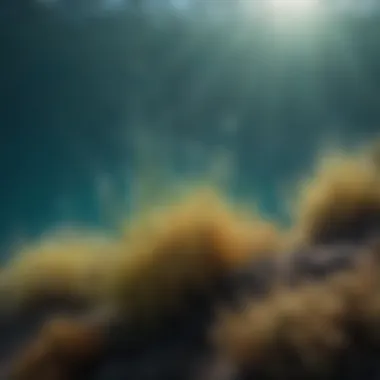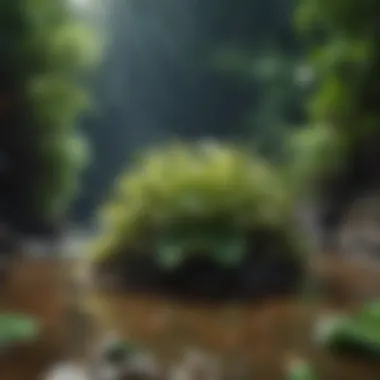Exploring Oceanic Vegetation: Marine Plants Unveiled


Nature Topic Overview
Marine plants, often overshadowed by their land counterparts, are crucial for the health of our oceans. They create vibrant ecosystems, serve as vital food sources, and help in regulating the environment. Understanding these plants is key, especially for young learners. They can grow in various forms like seagrasses, macroalgae, and tiny phytoplankton.
Seagrasses flourish in shallow waters, providing habitats for fish and securring sediments. Macroalgae, notably kelp, offer shelter and nourishment to various marine organisms. Phytoplankton, despite their minuscule size, are primary producers and form the very base of the marine food web. Each group has distinct roles and characteristics that impact marine ecosystems and the global environment.
This article will delve into these categories, highlighting their significance and contributions to marine biodiversity. Through this exploration, readers will gain insights into the beauty and complexity of marine flora, enriching their knowledge of life beneath the waves.
Fun Facts and Trivia
- Seagrasses can grow up to 60 cm per week in ideal conditions.
- There are over 10,000 species of marine algae, making them incredibly diverse.
- Phytoplankton produce around 50% of the oxygen we breathe!
These facts can spark curiosity among young readers, encouraging them to question and explore further.
Wildlife Explorations
In the ocean, every plant has a relationship with animals. For example, seagrasses are home to manatees and various fish species. They play a role in protecting coastlines too. Macroalgae provide food for species like sea urchins and snails. Here are some species you might find:
- Green Sea Turtle: Relies on seagrass for food.
- Giant Kelp: Offers shelter to numerous fish.
- Dinoflagellates: A type of phytoplankton, they can illuminate the ocean at night.
This interaction between marine plants and wildlife forms a delicate balance within the ecosystem.
Environmental Awareness
Conservation of these marine plants is crucial. They face threats from pollution, climate change, and habitat destruction. Children can help in various ways. Simple actions like reducing plastic use, participating in local cleanups, or learning to appreciate marine environments can make a difference. Raising awareness about the significance of these plants nurtures a sense of responsibility toward the oceans.
DIY Nature Activities
Engaging with nature can be a fun educational experience. Here are activities for kids:
- Seagrass Observations: Visit a beach and try to identify local seagrass species. Can you spot any fish?
- Kelp Crafts: Collect fallen leaves from land plants that resemble a kelp structure at home. Create a collage or drawing to understand its colorful forms.
- Phytoplankton Science: Create simple water filters using layers of sand and gravel to learn how water gets cleaned and observe what lives in it.
These hands-on projects reinforce learning and deep connections with marine ecosystems, opening up new ways to think about protecting them.
Prolusion to Marine Plants
Marine plants are a vital component of the ocean's ecosystem. These plants include seagrasses, macroalgae, and phytoplankton, and they play significant roles in maintaining ocean health. Understanding marine plants helps us appreciate their contributions to life underwater. They are foundational in the food web and support various forms of marine life.
Defining Marine Plants
Marine plants are organisms that grow in marine environments. They can be found in oceans, seas, and even in brackish waters. Unlike land plants, marine plants are specially adapted to withstand saltwater. Some notable groups of marine plants include seagrasses, which are flowering plants found in shallow coastal waters, macroalgae, which are larger algae commonly known as seaweeds, and phytoplankton, tiny organisms that float in the water column.
Characteristics of Marine Plants:
- Adaptations to Saltwater: Marine plants have unique adaptations that enable them to thrive in salty environments.
- Photosynthesis: Like land plants, marine plants also perform photosynthesis, converting sunlight into energy.
- Reproductive Strategies: Marine plants reproduce in various ways, including flowering, fragmentation, and spore production.
Importance of Marine Vegetation
Marine vegetation is essential for several reasons. First, they contribute significantly to oxygen production. Through photosynthesis, marine plants release oxygen into the water, which is crucial for the survival of marine animals.
Second, these plants play a major role in carbon sequestration. They absorb carbon dioxide, helping to mitigate climate change effects. Also, marine vegetation provides habitat and food for a diverse array of marine life. Fish, invertebrates, and many other organisms depend on these plants for sustenance and shelter.
Marine plants are not only vital for marine ecosystems but also for human life as they contribute to oxygen levels and carbon clean-up.
In summary, understanding marine plants gives us insight into their complex roles and importance in the marine environment. Their presence is fundamental to ecological balance, and protecting them is essential for the health of our oceans.
Types of Marine Plants
Understanding the various types of marine plants is essential to grasping their significance in oceanic environments. These plants are not just simple flora; they play roles vital to marine ecosystems. Each type of marine plant, like seagrasses, macroalgae, and phytoplankton, contributes uniquely to biodiversity and ecological health. Their study enlightens us on how they support marine life and sustain oceanic processes.
Seagrasses
Characteristics of Seagrasses
Seagrasses are unique flowering plants found in marine environments. Unlike other plants, they have adapted to grow underwater and can photosynthesize, which is crucial for their survival. Their long, ribbon-like leaves provide habitat for small fish and invertebrates. These characteristics make seagrasses an important focus for understanding marine plants.
One key characteristic is their ability to stabilize sediment. This prevents erosion along coastlines and maintains habitat areas for diverse marine life, highlighting their ecological importance. However, their fragility also poses risks. Human activities and climate change can damage these valuable plants.
Habitat and Distribution
Seagrasses thrive in shallow coastal waters around the globe, typically in sandy or muddy substrates. They flourish in warm waters but can also be found in temperate regions. Their habitat is crucial for many marine organisms, providing not only shelter but also breeding grounds.
A unique feature of seagrass habitats is their role in nutrient cycling. As they filter the water, they improve water quality. This characteristic has significant advantages. Yet, changes in sea levels or water pollution can severely affect their distribution, showcasing the threats they face.


Ecological Role of Seagrasses
Seagrasses play a pivotal role in marine ecosystems. They are known for producing oxygen through photosynthesis. Additionally, they serve as a food source for various marine species, including manatees and turtles. Their dense underwater meadows create vital nurseries for juvenile fish.
One unique feature is their symbiotic relationship with other organisms, such as epiphytic algae. These interactions enhance the biodiversity of marine life around them. However, their ecological role demands protection from over-exploitation and habitat degradation.
Macroalgae
Types of Macroalgae
Macroalgae, commonly known as seaweeds, come in several forms: green, brown, and red algae. Each type plays an essential part in its ecosystem. For example, kelp can grow large enough to create underwater forests providing habitat.
A key characteristic is their size and structure, making them photosynthetic powerhouses that enhance oxygen production in the ocean. Their diversity allows them to occupy different niches in marine environments, proving beneficial for various organisms. However, some types can be harmful when they overgrow due to nutrient pollution.
Growth and Reproduction
Macroalgae exhibit varied growth patterns, from fast-growing kelp to slower-growing red algae. Their growth strategies can depend on environmental factors like light and temperature. These plants reproduce both sexually and asexually, enabling their populations to remain stable.
A unique aspect is their resilience; many macroalgae can regenerate quickly if damaged. This characteristic positions them well in recovering from disturbances, though excessive runoff can hinder their reproductive success.
Role in the Ecosystem
Macroalgae play an essential role in nutrient cycling and serving as a habitat for many marine species. They are primary producers in the food web, forming the base for many marine food chains. Fish and shellfish rely on macroalgae for food and shelter.
One key feature is their ability to absorb excess nutrients, purifying the water. This function has ecological benefits; however, competition for space can occur when macroalgae overgrow due to pollution.
Phytoplankton
What is Phytoplankton?
Phytoplankton are microscopic plants that float in the ocean. These organisms are critical for marine ecosystems. They are primary producers, like larger plants, but their size allows them to thrive in almost all oceanic conditions.
A key characteristic is their ability to perform photosynthesis, converting sunlight into energy. This biomass forms the basis of aquatic food webs, underscoring their role in supporting marine life. However, their small size can make them vulnerable to changes in water quality and climate.
Types and Their Significance
Phytoplankton can be classified into two main types: diatoms and dinoflagellates. Diatoms have silica cell walls, while dinoflagellates can exhibit bioluminescence. These groups differ in their ecological roles and contributions.
One unique aspect of phytoplankton is their rapid reproduction rate, allowing populations to rebound quickly. This characteristic supports marine food chains. Still, their health can be threatened by pollution and climate shifts, emphasizing the need for monitoring.
Photosynthesis in the Ocean
Photosynthesis conducted by phytoplankton is vital for the oceanic ecosystem. This process not only produces oxygen but also absorbs carbon dioxide, playing a significant role in moderating climate.
A key characteristic of this process is its efficiency; phytoplankton can convert sunlight with high effectiveness, making them integral to ocean health. The unique feature is their ability to thrive even in nutrient-poor waters. However, they face risks from over-fishing and changes to marine environments.
Phytoplankton's role in the ocean is primarily about producing oxygen and absorbing carbon dioxide, linking them to the broader climate system.
In summary, the types of marine plants are diverse and integral to ocean ecosystems. They support marine life and contribute to vital processes of life underwater.
Habitats of Marine Plants
Marine plants thrive in various habitats, each playing a critical role in supporting marine ecosystems. Understanding these environments is fundamental to appreciating how marine flora functions and interacts with its surroundings. Habitats such as coastal areas, coral reefs, and open ocean zones each provide unique benefits that contribute to the overall health of oceanic ecosystems.
Coastal Areas
Types of Coastal Vegetation
Coastal vegetation includes various types like mangroves, salt marshes, and seagrasses. These plants are essential because they stabilize shorelines and provide habitat for numerous marine species. Mangroves, for instance, are known for their complex root systems, which protect coastal areas from erosion. Salt marshes are typically dominated by grasses, while seagrasses flourish underwater. They all serve as nurseries for fish, shrimp, and other marine life, making them vital for biodiversity.
Key Characteristics
One main characteristic of coastal vegetation is its ability to tolerate saline conditions. This adaptation is crucial as coastal areas are often influenced by saltwater from the ocean.
Unique Features
The unique features of these ecosystems include their role in filtering pollutants and improving water quality. Coastal vegetation acts like a buffer, absorbing excess nutrients and contaminants before they reach open waters. This function is beneficial, yet these areas face threats from development and pollution.
Interactions with Marine Life
Coastal vegetation provides habitat, food, and protection for a multitude of marine organisms. Fish, crabs, and birds rely on these areas for survival, highlighting the interconnectedness of marine life.
Key Characteristics
One key characteristic of these interactions is the shelter provided by coastal plants, allowing young fish and invertebrates to grow away from predators.


Unique Features
These interactions are characterized by complex food webs where various organisms depend on each other, contributing to the overall productivity of marine ecosystems. However, loss of coastal habitats can disrupt these relationships, leading to declines in marine populations.
Coral Reefs
Role of Flora in Coral Reefs
Coral reefs support diverse marine plants, like various types of algae, including zooxanthellae. These plants are crucial since they contribute to the energy needs of coral through photosynthesis. Symbiotic relationships between coral and algae enhance the health of reefs.
Key Characteristics
The key characteristic of flora in coral reefs is their ability to support the structure and function of the reefs. Without this plant life, reef ecosystems would collapse.
Unique Features
These plants help create a habitat for hundreds of marine species. Their role in nutrient cycling and providing shelter highlights their importance, yet reefs are threatened by climate change and pollution.
Biodiversity and Health of Reefs
Biodiversity in coral reef habitats is vital for their overall health. Rich plant life promotes a variety of marine species. Healthy coral reefs also outperform those that are degraded by delivering essential ecosystem services.
Key Characteristics
A high level of biodiversity indicates a resilient ecosystem. This diversity is crucial for maintaining ecological balance.
Unique Features
Increased biodiversity ensures stability in coral ecosystems, but factors like ocean acidification jeopardize this balance, posing serious threats to marine life.
Open Ocean Environments
Surface vs. Deep Ocean Vegetation
Surface ocean areas are rich with phytoplankton, while deeper layers often lack light. Despite this, organisms like kelp can flourish in specific regions. Understanding these differences sheds light on nutrient distribution in oceans.
Key Characteristics
Surface vegetation serves as a foundational part of the marine food web. Phytoplankton, for example, produces a significant percentage of the world’s oxygen.
Unique Features
Each zone has unique adaptations; surface plants rely on sunlight, while those in deeper waters must cope with darkness.
Adaptations to Different Conditions
Marine plants have developed unique adaptations to survive in various oceanic conditions. Such adaptations are essential for thriving in environments that differ significantly in light availability, pressure, and temperature.
Key Characteristics
The adaptability of marine flora is a critical asset for their survival, allowing them to flourish in both shallow and deep water zones.
Unique Features
These adaptations can include thicker cell walls or specialized pigments to capture sunlight more effectively. However, changes due to environmental stressors can impact their ability to adapt.
The Role of Marine Plants in Ecosystems
Marine plants play a fundamental role in ocean ecosystems. Their contributions are multi-faceted, affecting everything from the atmosphere to the food web. Understanding these roles helps illuminate the significance of preserving marine flora.
Oxygen Production
One of the most critical functions of marine plants is their ability to produce oxygen. Through the process of photosynthesis, seagrasses, macroalgae, and phytoplankton absorb carbon dioxide and release oxygen into the water. This process is vital for the survival of aquatic life. In fact, it is estimated that phytoplankton alone is responsible for producing up to 50% of the Earth's oxygen. Without oxygen produced by these plants, marine organisms would struggle to thrive. This highlights not just the role of plants in marine environments, but also their importance for global health.
Carbon Sequestration
Marine plants also play a significant part in carbon sequestration. This is the process of absorbing carbon dioxide from the atmosphere and storing it. Seagrasses, for example, can trap carbon in their roots and in the sediment below them. They can even sequester carbon for thousands of years. This is an essential mechanism for combating climate change, as it helps reduce the amount of carbon dioxide in the atmosphere. Protecting marine plants ensures that they can continue to play this pivotal role in maintaining climate balance.
Food Source for Marine Life
Lastly, marine plants serve as a crucial food source for a variety of marine creatures. Many small organisms feed on phytoplankton, forming the base of the marine food web. This chain continues as larger fish and marine mammals rely on those smaller organisms for sustenance. For instance, many species of fish depend on seagrass beds for shelter and food. The presence of healthy marine vegetation means a richer diversity of marine life. Therefore, the decline of marine plants can lead to decreases in fish populations and overall marine biodiversity.
"The health of marine ecosystems is directly tied to the prosperity of marine plants. Protecting these vital resources is imperative for future generations."
In summary, the role of marine plants in ecosystems is irreplaceable. They are essential for oxygen production, carbon storage, and as a food source for countless marine species. Their preservation is not just about protecting a single species but maintaining a healthy and balanced ocean ecosystem.


Threats to Marine Flora
Marine flora, which includes vital components like seagrasses, macroalgae, and phytoplankton, faces several critical threats. Understanding these dangers is essential for protecting our oceans. Threats to marine plants not only affect their health but can also lead to severe consequences for the entire marine ecosystem. Each piece of vegetation plays a role in maintaining a balanced ocean, and any disruption can bring significant changes.
Climate Change
Climate change is a major concern for marine vegetation. Temperature rise in oceans can disrupt growth patterns and lead to habitat loss. As the waters warm, some plants may struggle. For example, seagrasses require specific temperature ranges and light levels. Warming waters can cause their distribution to shift, affecting their ability to thrive. More frequent storms and altered ocean currents can uproot these vital plants or bury them under sand and debris. The change in temperatures also impacts the photosynthesis process in phytoplankton, crucial for oxygen production. When phytoplankton populations decline, it can trigger changes across the entire marine food web.
Pollution
Pollution presents another significant threat to marine flora. From agricultural runoff to plastics, pollutants can have a devastating impact. Nutrient pollution, primarily from fertilizers, can lead to algal blooms that consume oxygen in the water. This phenomenon creates dead zones where marine plants cannot survive. Additionally, plastic debris can entangle or damage marine vegetation. Pollution not only affects physical health but also the overall biodiversity of marine plant life. Reduction in biodiversity can lead to an unstable ecosystem, making it less resilient to changes.
Overexploitation and Habitat Loss
Overexploitation of marine resources contributes to habitat loss for marine plants. Coastal development activities, such as the construction of ports or resorts, often destroy natural habitats crucial for marine flora. Seagrass beds, for example, may be damaged during dredging activities or coastal land reclamation. Furthermore, harvesting practices, including the removal of algae for food or decorative purposes, can have unintended consequences. Removing large amounts of macroalgae can disrupt habitats that some fish depend on. As a result, the loss of these plants can lead to decreased fish populations, impacting those that rely on fishing as a livelihood.
"Protecting marine plants is crucial for maintaining the health of our oceans. Each plant plays a key role."
Overall, awareness of the threats to marine flora is a first step toward conservation efforts. Understanding how marine plants are affected is vital for developing strategies to protect them. As young learners, educators, and parents discuss these issues, they can inspire future generations to respect and safeguard our oceanic environments.
Conservation Efforts for Marine Vegetation
Conservation of marine vegetation is essential for many reasons. These plants support a variety of marine life and contribute to the overall health of ocean ecosystems. Marine plants like seagrasses, macroalgae, and phytoplankton are key to maintaining biodiversity, preventing erosion, and producing oxygen. The protection and restoration of these valuable habitats is not only important for marine organisms but also for human communities that depend on healthy oceans.
Protected Areas
Establishing protected areas is one vital strategy in the conservation of marine plants. These areas limit human activities that can harm the environment, such as fishing, pollution, and coastal development. Marine Protected Areas (MPAs) create safe havens for marine flora and fauna to thrive. They help to restore ecosystems that have been degraded, allowing for recovery of species and habitats. For example, seagrass beds can benefit from reduced boat traffic and fishing, leading to improved underwater landscapes where many organisms can live and reproduce.
"Protected areas are vital for the recovery of marine ecosystems affected by human activity."
Not only do these protected regions aid in the recovery of marine vegetation, they also enhance local economies through eco-tourism. By protecting marine plants, we are also protecting the animals that rely on these habitats. This interconnectivity emphasizes the importance of conservation initiatives aimed at establishing MPAs.
Restoration Projects
Restoration projects are another crucial element in conserving marine vegetation. These projects involve active efforts to rebuild and rejuvenate damaged marine ecosystems. Examples include replanting seagrass in areas where it has declined or removing invasive algae that can harm local species. Marine restoration projects often rely on volunteer support and community involvement, making it a collective effort.
The success of restoration projects can be measured by how well marine life returns to these areas. Healthy seagrass beds not only stabilize the ocean floor, but also provide nursery habitats for fish and crustaceans. Similarly, restoring kelp forests can increase biodiversity, ensuring that the ecosystem remains robust.
Community Engagement and Education
Engaging communities and educating them about the importance of marine plants is fundamental to successful conservation efforts. Awareness programs can teach people about the critical roles that marine vegetation plays in ecosystems. Schools, local organizations, and online platforms can inspire care for marine environments. Educational activities can involve beach clean-ups or school-based projects that include monitoring local marine plant life.
Community involvement fosters a sense of ownership and responsibility toward marine conservation. When people understand how their actions impact the ocean, they are more likely to promote and engage in sustainable practices. Collaborating with community members also helps to gather valuable data for scientists who study these plants.
Future of Marine Flora Research
Exploring the future of marine flora research is essential for understanding the dynamics of oceanic ecosystems. Marine plants are critical components of these environments, and research in this field can highlight their adaptive mechanisms and responses to environmental change. By studying marine vegetation, researchers can discover ways to enhance their conservation and restoration efforts. Awareness of their importance has grown, and ongoing research will be pivotal in fostering a sustainable marine environment, benefiting both biodiversity and human activity.
Technological Advances
Technological advances play a crucial role in marine flora research. With tools like remote sensing and underwater drones, scientists can gather data on marine plants with unprecedented detail. These technologies help monitor health and distribution of marine vegetation over large areas.
For instance, satellite imagery can provide a broader perspective on seagrass beds, allowing researchers to identify changes in habitat due to climate change or human impacts. Additionally, genetic sequencing technology can reveal the genetic diversity of marine plants, aiding in species conservation efforts.
The use of advanced modeling systems also offers insights into how marine plants respond to various environmental factors. This understanding is vital for predicting future changes in ocean health due to climate shifts or pollution. The integration of these technologies leads to better-informed decisions about conservation strategies.
Integrating Marine Research with Climate Science
The connection between marine research and climate science is increasingly important. As climate change continues to influence seawater temperatures and acidification, the resilience of marine flora is under threat. Integrating climate science with marine studies will provide a more comprehensive understanding of these plants’ responses to changing conditions.
Scientists work to determine how various factors, like temperature change or altered nutrient levels, affect marine plants. Research focuses on questions such as how rising temperatures could impact phytoplankton productivity or how increased carbon dioxide levels might affect seagrass health.
A combined approach allows for better predictions about the future of marine ecosystems. Working collaboratively, climate scientists and marine biologists can create models that help anticipate changes, giving policymakers and conservationists the tools needed to devise effective management strategies.
"Understanding the interplay between marine plants and climate is vital for ensuring the health of our oceans. This knowledge is needed now more than ever as we face significant environmental changes."
In summary, the future of marine flora research is pivotal in addressing the challenges posed by climate change. Technological advancements and the integration of climate science will enhance our understanding of how marine vegetation can adapt, survive, and continue to play its crucial role in ocean ecosystems.
Culmination
The conclusion of this article serves as a vital synthesis of the information presented about marine plants and their significance in oceanic environments. Understanding marine vegetation is essential not only for scientific study but also for ecological awareness. Marine plants, such as seagrasses, macroalgae, and phytoplankton, play crucial roles in strengthening the health of our oceans. They produce oxygen, sequester carbon, and act as a food source for various marine species.
Summary of Key Points
- Diversity of Marine Plants: The ocean is home to a wide range of plant life, each contributing uniquely to its ecosystem. Seagrasses provide habitat, whereas macroalgae are vital for nutrient cycling.
- Ecosystem Functions: Marine plants are fundamental in maintaining the balance of oceanic ecosystems. They support biodiversity and help combat climate change.
- Threats and Conservation: Many marine plants face threats from climate change, pollution, and habitat loss. Conservation efforts are increasingly critical in protecting these vital resources.
The Importance of Ongoing Education
Education about marine flora is key for the younger generation. Educators and parents can nurture interest in oceanic studies through engaging activities and discussions. Learning about marine plants promotes environmental stewardship, encouraging children to appreciate and protect our oceans. By fostering this understanding, we can inspire future generations to take part in conservation efforts. The continuous sharing of knowledge about marine ecosystems benefits society as a whole, ensuring that marine vegetation is recognized as a critical component of our planet’s health.
"Understanding oceanic flora is not just for scientists; it is essential for every individual who seeks to protect our planet."







